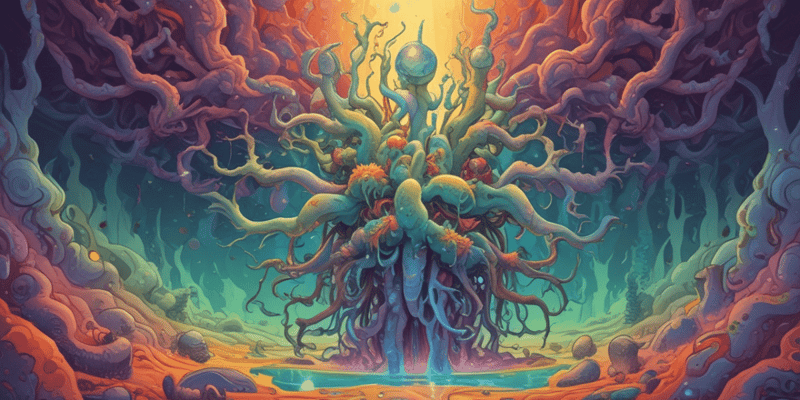8 Questions
What are the three parts of an endotoxin composed of?
O antigen, core polysaccharide, and toxic Lipid A
What is the result of the interaction between endotoxins and factor H?
Activation of the coagulation cascade
How does diphtheria toxin stop protein synthesis?
By using ADP-ribosyl transferase to ribosylate EF2
What is the effect of edema factor in anthrax toxin?
Conversion of ATP to cAMP, increasing fluid
What is the primary virulence factor of C.difficile?
TedB
What is the role of alpha toxin in C.perfringens?
Causing clostridial myonecrosis through its phospholipase activity
How does CPE toxin cause food poisoning?
By forming pores in the membrane, binding to claudin receptors, and interacting with occludin
What is the result of TedA and TedB toxins on the cytoskeleton?
Disruption of the cytoskeleton and leading to cell death
Study Notes
Endotoxins
- Associated with the cell wall of gram-negative bacteria
- Composed of three parts: O antigen, core polysaccharide, and toxic Lipid A
- Pyrogenic, triggering the release of IL-1 and TNF from macrophages
- Activate the complement cascade, leading to edema and neutrophil chemotaxis
- Interact with factor H, triggering the coagulation cascade
Exotoxins
- Pore-forming toxins assemble before or after insertion into the membrane
- Phospholipase breaks phospholipids
- Diphtheria toxin: an AB toxin that uses ADP-ribosyl transferase to ribosylate EF2, stopping protein synthesis
Anthrax Toxin
- Encoded on a plasmid
- Consists of three proteins: edema factor (EF), lymph factor (LF), and protective antigen (B component)
- EF converts ATP to cAMP, increasing fluid
- LF inactivates MAPKK, leading to apoptosis
Other Toxins
- Mycolactone: a non-protein AB toxin that is cytotoxic and causes the Buruli ulcer
- Tilivalline: a non-protein AB toxin that is an enterotoxin associated with antibiotic-associated haemorrhagic colitis
C. difficile
- Causes a spectrum of disease, including diarrhea, toxic megacolon, and sepsis
- Produces two toxins, TedA and TedB, which disrupt the cytoskeleton and lead to cell death
- Toxins have an ABCD structure, with A = activity, B = binding, C = cutting, and D = delivery
- TedB is the primary virulence factor, confirmed by studies with isogenic mutants
C. perfringens
- Produces up to 17 different toxins
- Alpha toxin is essential for gas gangrene and causes clostridial myonecrosis through its phospholipase activity
- CPE toxin causes food poisoning by forming pores in the membrane, binding to claudin receptors, and interacting with occludin
- This leads to tight junction damage, disruption of the epithelial permeability barrier, and symptoms
C. botulinum
- Causes three types of botulism: foodborne, wound, and floppy baby syndrome
- BoNT toxin is an AB toxin that enters neurons and causes endosome acidification
- The light chain of the toxin is cleaved and cleaves SNARE family proteins, blocking the release of acetylcholine into the synaptic cleft
- Blocking SNARE complex formation leads to membrane fusion of neurotransmitters, causing paralysis
This quiz covers the structure, function, and effects of bacterial toxins, including endotoxins and exotoxins. Learn about their composition, mechanisms of action, and interactions with the immune system.
Make Your Own Quizzes and Flashcards
Convert your notes into interactive study material.
Get started for free



